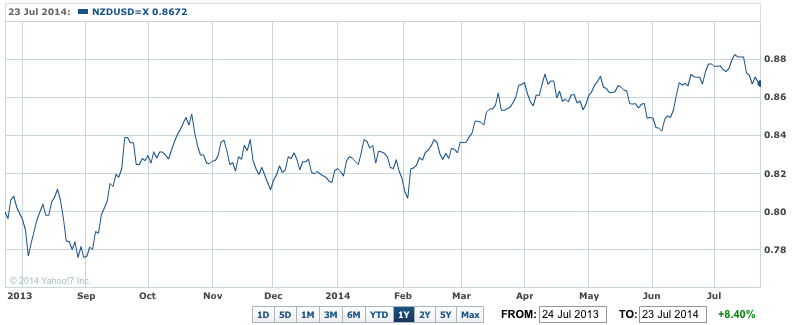The Reserve Bank of New Zealand has imposed another check to the possibility of an inflation break out across the Tasman with its fourth rate rise this year this morning.
The central bank boosted its official cash rate (OCR) 0.25% to 3.25, continuing the series of increases that have lifted the rate by 1% since March.
The bank also signalled a halt to more rate rises for the time being, and warned that current the high value of the Kiwi dollar is unsustainable, and warned that a sharp fall could happen soon.
That pause will be welcomed by Australian companies operating in NZ, especially the banks and retailers such as Woolworths. But they are all enjoying stronger trading conditions across the Tasman than they are in Australia, and judging by the comments in this morning’s statement, those conditions will continue for the rest of this year.
But the RBNZ now sees it necessary for a ‘watch and wait’ policy – much like the RBA, though its current stance is watching and waiting to see what record low rates and rate cuts will have on the Australian economy, not rate rises.
"It is prudent there now be a period of assessment before interest rates adjust further towards a more neutral level," Governor Wheeler said in the statement issued early this morning.
"With the exchange rate yet to adjust to weakening commodity prices, the level of the New Zealand dollar is unjustified and unsustainable and there is potential for a significant fall," RBNZ Governor Graeme Wheeler warned in his statement this morning.
The Kiwi dollar rose before the announcement to just over 87 US cents, then fell almost a cent in the wake of the news.
NZDUSD 1Y – RBNZ looks to curb Kiwi dollar

Those comments on the value of the Kiwi dollar are similar to those from the Reserve Bank of Australia, Governor Glenn Stevens and other senior officials in the past year or more.
They have pointed to the fall in the prices of key Australian exports, such as iron ore , coal and wheat have fallen sharply in the past year or so (especially iron ore and coal), dragging down our terms of trade, and yet the value of the Aussie dollar hasn’t fallen to match that drop.
It’s the price Australia, and NZ are paying for well run, open economies with high credit ratings, offering high yield assets (especially after the four rate rises in NZ this year).
The RBA has warned of a possible fall in the value of the currency, but the market hasn’t been listening and the NZ warning will fall on deaf ears as well, meaning the Kiwi currency will remain at its currency elevated level for a while yet.
The big possible turning point ahead is around the planned ending to the US Federal Reserve’s ending of its bond buying in October – that could rattle markets and send the Aussie and Kiwi dollars lower, or nothing could happen.
The central bank said the rate rise was made to help control the strongly growing economy which is expected to see growth reach an annual rate of 3.7% this year.
"Inflation remains moderate, but strong growth in output has been absorbing spare capacity," the RBNZ statement said.
"This is expected to add to non-tradables inflation. Wage inflation is subdued, reflecting recent low inflation outcomes, increased labour force participation, and strong net immigration."
"It is important that inflation expectations remain contained," the bank explained in its statement.
"Today’s move will help keep future average inflation near the 2 percent target mid-point and ensure that the economic expansion can be sustained.
"Encouragingly, the economy appears to be adjusting to the monetary policy tightening that has taken place since the start of the year."
But the bank’s moans about the high value of the Kiwi dollar seem forlorn and a bit naive.
"Over recent months, export prices for dairy and timber have fallen, and these will reduce primary sector incomes over the coming year," Mr Wheeler said in his statement, echoing comments from the RBA and Governor Glenn Stevens.
The RBNZ seems unable to accept that as a high performing, high yield (especially with the rate rises this year) economy and a solid AA stable credit rating, NZ assets are prime targets for big global investors looking for yield.
It’s the same situation we in Australia are experiencing.
There are more Australian securities (government and private) available than there are NZ assets, so Australia soaks up a lot of the demand for high grade high yield assets.













